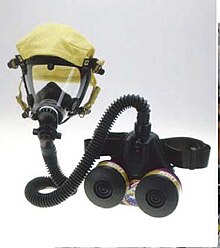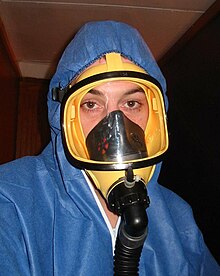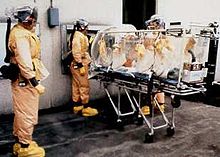Powered air-purifying respirator


A powered air-purifying respirator (PAPR) is a type of
Description
The modularity of PAPRs allows them to be customized for different working environments. Regardless of type, a PAPR consists of:[1]
- some kind of headgear (mask or hood),
- a powered (motor-driven) fanwhich forces incoming air into the device,
- a filter(or multiple filters) for delivery to the user for breathing, and
- a battery or other power source.
The mask may be hard and tight-fitting, or flexible and loose-fitting. The former affords a higher level of protection, but is less comfortable.[2] Tight-fitting PAPRs require a fit test, while loose-fitting ones do not. This makes loose-fitting PAPRs useful when a fit test for a tight-fitting respirator cannot be successfully passed, for example when facial hair is present.[2][3] Masks may be reusable or disposable. Some masks allow the full face to be seen by others, aiding in interpersonal communication.[1]
The fan, filter, and power-pack may be carried around freely by the user, often secured by a belt around the waist. Alternatively, with certain units, the air is fed to the user via lengthy tubing while the fans and filters are remotely mounted.[citation needed]
PAPRs have low breathing resistance, unlike filtering facepiece respirators such as
Filters
PAPRs may be outfitted with
In the United States, HE (high-efficiency) filters are the class of particulate filter used with PAPRs. These are 99.97% efficient against 0.3 micron particles, the same as a P100 filter.[1][8][9] PAPR HE filters used in industry are generally re-used until they are soiled, damaged, or reduce PAPR air flow below specified levels. In healthcare settings involving a live virus, CDC recommends that a practical replacement cycle be implemented.[1]
The type of filter incorporated into a PAPR must be appropriate to the contaminants that need to be removed. Some respirators are designed to remove fine particulate
When used in combination with the correct filters, [PAPRs] are suitable for working with volatile
Usage

According to the NIOSH Respirator Selection Logic, PAPRs are recommended for concentrations of hazardous particulates or gases that are greater than the relevant
PAPRs have the advantage of eliminating breathing resistance caused by unpowered negative-pressure respirators such as
In healthcare
Because they provide higher assigned protection factors, PAPRs are suitable for use during aerosol-generating procedures[1] and by hospital first receivers.[1][10] In healthcare settings, CDC recommends cleaning of all components except the filter after each use; care must be taken to select PAPRs that are not damaged or deteriorate due to cleaning and disinfecting agents.[11][1]

In healthcare, a product known as the
For CBRN defense

Some PAPRs have special certification for chemical, biological, radiological, and nuclear contaminants (CBRN). In the United States, they must be certified to resist permeation of chemical warfare agents, which may involve additional protective coverings; that gas or vapor will not pass through the filter before a specified amount of time; and its ability to fit a wide range of facial sizes and shapes.[14]
Under immediately dangerous to life or health (IDLH) conditions, tight‐fitting full facepiece gas mask respirators with canisters (those with "14G approval") with CBRN approval may be used for escape, but loose‐fitting hoods and cartridges (those with "23C approval") with CBRN approval may not. Neither may be used to enter an IDLH atmosphere. The 23C CBRN PAPRs also must not be used if liquid droplet exposure occurs.[14]
See also
References
- ^ a b c d e f g h "Considerations for Optimizing the Supply of Powered Air-Purifying Respirators (PAPRs)". U.S. Centers for Disease Control and Prevention. 2020-04-19. Retrieved 2020-05-25.
- ^ a b c d e Bach, Michael (2017-07-06). "Understanding respiratory protection options in healthcare: the overlooked elastomeric". NIOSH Science Blog. Retrieved 2020-04-21.
- ^ a b c d e Garvey, Donald J. (2010-04-01). "Constructing a Powered Air Purifying Respirator System". EHS Today. Retrieved 2020-04-21.
- ^ "Powered Air Purifying Respirator (PAPR)". Minnesota Department of Health. Retrieved 2020-05-25.
- ^ . Retrieved 2020-04-20.
- ^ File:Respirator Types.webm, time 8:19 (loose) and 8:43 (tight-fitting)
- ^ "Considerations for Optimizing the Supply of Powered Air-Purifying Respirators (PAPRs)". US Centers for Disease Control and Prevention. 11 February 2020.
- PMID 26078617.
- ^ "Understanding Respiratory Protection Against SARS". U.S. National Institute for Occupational Safety and Health. 2020-04-09. Retrieved 2020-05-26.
- ^ "Best Practices for the Protection of Hospital-Based First Receivers from Mass Casualty Incidents Involving the Release of Hazardous Substances". U.S. Occupational Safety and Health Administration. 2005-01-01. Retrieved 2020-05-26.
- ^ "PAPR - Powered Air Respirators". www.envirosafetyproducts.com. Retrieved 2021-10-12.
- ^ "The threat to the United States from Emerging Infectious Diseases, Hearing before the Committee on International Relations, House of Representatives". 30 July 1997: 9. Retrieved 15 April 2015.
{{cite journal}}: Cite journal requires|journal=(help) - ^ Sidell, Frederick R.; Takafuji, Ernest T.; Franz, David R., D.V.M. (1997). "19". Medical Aspects of Chemical and Biological Warfare. Office of The Surgeon General Department of the Army, United States of America. Retrieved 15 April 2015.
{{cite book}}: CS1 maint: multiple names: authors list (link) - ^ doi:10.26616/NIOSHPUB2013156. Retrieved 2020-05-25.)
{{cite journal}}: Cite journal requires|journal=(help
